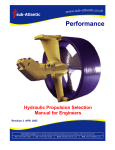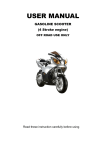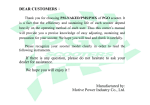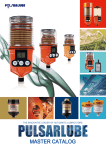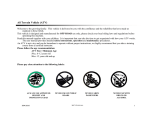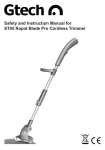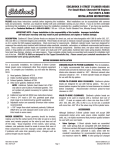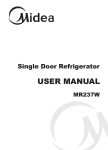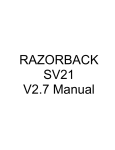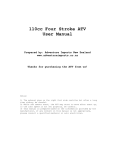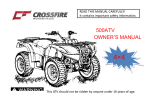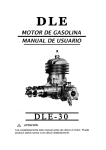Download FA-D50
Transcript
USER MANUAL READ THIS MANUAL CAREFULLY. It contains important safety information. □50 □70 □90 □110 INTRODUCTION This manual will provide you with a clear understanding of the details and operation of this vehicle. This manual includes all of the necessary safety information. It provides information necessary to ride your vehicle and also includes basic service and inspection procedures. AN IMPORTANT SAFETY MESSAGE: ● READ THIS MANUAL CAREFULLY AND COMPLETELY BEFORE OPERATING YOUR VEHICLE. MAKE SURE YOU UNDERSTAND ALL INSTRUCTIONS. ● PAY CLOSE ATTENTION TO THE WARNING AND CAUTION LABELS ON THE VEHICLE. ● NEVER OPERATE AN ATV WITHOUT PROPER TRAINING OR INSTRUCTION. IMPORTANT MANUAL INFORMATION: FAILURE TO FOLLOW THE WARNINGS CONTAINED IN THIS MANUAL CAN RESULT IN SERIOUS INJURY OR DEATH. Particularly important information is distinguished in this manual by the following notations: ATTENTION: The Safety Alert Symbol means ATTENTION! BE ALERT! YOUR SAFETY IS INVOLVED! WARNING: Failure to follow WARNING instructions could result in severe injury or death to the vehicle operator, a bystander or a person inspecting or repairing the vehicle. CAUTION: A CAUTION indicates special precautions that must be taken to avoid damage to the vehicle. NOTE: A NOTE provides key information to make procedures easier or clearer. IMPORTANT NOTICE This vehicle is designed and manufactured for OFF-ROAD use only. It is illegal and unsafe to operate this machine on any public street, road or highway. This vehicle complies with all applicable OFF-ROAD noise level and spark arrester laws and regulations in effect at the time of manufacture. Please check your local riding laws and regulations before operating this machine. ! WARNING Indicates a potential hazard that could result in serious injury or death. CONTENTS: 1 LOCATION OF THE "WARNING AND SPECIFICATION LABELS"… … … … ....... 1-1 2 SAFETY INFORMATION........................... 2-1 3 DESCRIPTION AND MACHINE IDENTIFICATION...................................... 3-1 Identification numbers record.................... 3-2 Vehicle identification number and engine I.D. number.................................... 3-2 4 CONTROL FUNCTIONS Main switch................................................ 4-1 Throttle lever.............................................. 4-1 Handlebar switches................................... 4-2 Emergency kill switch................................ 4-3 Front brake lever....................................... 4-4 Rear brake pedal....................................... 4-4 Parking brake............................................ 4-5 Speed limiter.............................................. 4-5 Seat.......................................................... 4-6 Fuel tank cap............................................ 4-6 Front shock absorber adjustment............. 4-7 Rear shock absorber adjustment.............. 4-7 5 PRE-OPERATION CHECKS..................... 5-1 Front and rear brakes................................ 5-2 Fuel........................................................... 5-2 Engine oil................................................... 5-3 Throttle lever.............................................. 5-4 Lights......................................................... 5-4 Switches.................................................... 5-4 Battery… … … … … … … … … … … … ............ 5-4 Tires.......................................................... 5-4 6 OPERATION To start out and accelerate… … … … … … ... 6-1 To decelerate............................................. 6-1 Engine break-in......................................... 6-2 Parking...................................................... 6-2 Parking on a slope..................................... 6-2 7 PERIODIC SERVICE................................. 7-1 Engine....................................................... 7-4 Engine oil................................................... 7-5 Idle speed adjustment............................... 7-6 Throttle lever adjustment........................... 7-6 Brake adjustment-rear brake..................... 7-7 Brake lever lubrication............................... 7-7 Fuse replacement...................................... 7-8 Battery asks for replenishment.................. 7-9 Replacing the headlight bulb..................... 7-9 Air filter cleaning… … … … … … … … … … … 7-9 8 SPECIFICATIONS..................................... 8-1 9 MAINTENANCE RECORD........................ 9-1 LOCATION OF THE "WARNING AND SPECIFICATION LABELS" Read and understand all of the labels on your quad. They contain important information for safe and proper operation of your quad. Never remove any labels from your quad. If a label becomes difficult to read or comes off, a replacement label is available from your dealer. 1-1 1 ○ 2 ○ 3 ○ 4 ○ 1-2 SAFETY INFORMATION TO DRIVE AN ATV IS A SERIOUS MATTER AND CAN BE HAZARDOUS TO OPERATE. An ATV handles differently from other vehicles including motorcycles and cars. A collision or rollover can occur quickly, even during routine maneuvers such as turning and riding on hills or over obstacles, if you fail to take proper precautions. SEVERE INJURY OR DEATH can result if you do not follow these instructions: ● Read this manual and all labels carefully and follow the operating procedures described. ● Never operate an ATV without proper training or instruction. ●A child under 16 years old should never operate an ATV. ● Never carry a passenger on an ATV. ● Always avoid operating an ATV on any paved surfaces, including sidewalks, driveways, parking lots and streets. ● Never operate an ATV on any public street, road or highway nor a dirt or gravel one. ● Never operate an ATV without wearing an approved motorcycle helmet that fits properly. You should also wear eye protection (goggles or face shield), gloves, boots, long-sleeved shirt or jacket, and long pants. ● Never consume alcohol or drugs before or while operating this ATV. ●Never operate at speeds too fast for your skills or the conditions. 2-1 ●Never attempt wheelies, jumps, or other stunts. ●Always inspect your ATV each time you use it to make sure it is in safe operating condition. ●Always follow the inspection and maintenance procedures and schedules described in this manual. ● Always keep both hands on the handlebars and both feet on the footboards of the ATV during operation. ●Never operate the ATV in fast flowing water or in water deeper than 25 cm (10 in.). ●Always use the size and type of tires specified in this manual. Always maintain proper tire pressure as described in this manual. ●Never modify the ATV through improper installation or use of accessories. ●Never exceed the stated load capacity for an ATV. Cargo should be properly distributed and securely attached. Reduce speed and follow instructions in this manual for carrying cargo or pulling a trailer. Allow greater distance for braking while transporting cargo. ! WARNING Always turn off the engine when refueling. Don’ t start or run the engine in a closed area to avoid potential hazard. 2-2 DESCRIPTION AND MACHINE IDENTIFICATION 1 ○ 2 ○ 3 ○ 4 ○ 5 ○ 6 ○ 7 ○ 8 ○ 9 ○ 10 ○ Rear rack Seat lock Seat Rear brake pedal (Foot operation) Main switch Handlebar Throttle lever Speed limiter Parking switch Front brake lever 3-1 Identification numbers record Record the vehicle identification number (VIN) and engine I.D. number in the spaces provided for assistance when ordering spare parts from your dealer or for reference in case the vehicle is stolen. 2. ENGINE I.D. NUMBER 1. VEHICLE IDENTIFICATION NUMBER Note: The vehicle identification number (VIN) is used to identify your ATV. The information of vehicle identification number and engine I.D. number will be needed to order spare parts from your dealer. The vehicle identification number is stamped on the front side of the frame. 3-2 CONTROL FUNCTIONS Main switch Functions of the respective switch positions are as follows: On: Engine can be started only at this position. Off: All electrical circuits are switched off. The key can be removed in this position. Throttle Lever Once the engine is running, movement of the throttle lever will increase the engine speed. Regulate the speed of the engine by varying the throttle position. Because the throttle is spring-loaded, the engine will decelerate, and the engine will return to an idle any time your finger is removed from the throttle lever. Before starting the engine, check the throttle to be sure it is operating smoothly. Make sure it returns to the idle position as soon as the lever is released. 4-1 Handlebar switches Start switch The starter motor cranks the engine when this switch is pushed. CAUTION: See starting instructions prior to starting engine. Lights switch Turn the switch on for front light and taillight (option accessory). 1. Engine stop switch (Red) 2. Start switch 3. Lights switch (Black) (option) Engine stop switch The engine stop switch controls the ignition and can be used at all times to stop the engine, especially in an emergency. The engine will not start or run when the engine stop switch is turned to “ ”. When starting the engine, the function button should be at “ ”position. CAUTION: Do not use the headlight with the engine turned off for more than 10 minutes. The battery may discharge to the point that the starter motor will not operate properly. If this should happen, remove the battery and recharge it, replace if necessary. 4-2 Emergency kill switch This switch is in the front of ATV, to which an adult can attach string, and follow the child. If the child needs to stop suddenly, or if the adult wants to stop engine for any reason, just pull the string. 4-3 Front brake lever The brake lever is located on the right side of the handlebar. Pull down on the lever to apply the front brake. Rear brake pedal The brake pedal is located on the right side of the frame. Step on the lever to apply the rear brake. 4-4 Parking brake Apply the brake lever and then press down the stop-button to apply the parking brake. Squeeze the rear brake lever to release the parking brake. Speed limiter The speed limiter keeps the throttle from fully opening, even when the throttle lever is pushed to the furthest position. Screwing in the adjuster limits the maximum engine power available and decreases the maximum speed of the ATV. For children’ s safety, this ATV has been adjusted to a speed under 35 km/h (22 mph). WARNING: Do not turn the speed adjuster out more than 12 mm (0.47 in.). Always make sure the throttle lever free play is 3~5 mm (0.12~0.20 in.). 4-5 Seat To remove the seat, pull the seat lock lever upward and pull up the seat at the rear. Fuel tank cap Remove the fuel tank cap by turning it counterclockwise. Automotive gasoline with octane number of 90 or higher may be used. After refueling, be sure to tighten the tank cap firmly. To install the seat, insert the lobe on the seat front into the receptacle on the frame and push down the seat at the rear. 4-6 Front shock absorber adjustment The spring preload can be adjusted to suit the vehicle’ s load and riding conditions. Spring preload adjustment: To increase the spring preload, turn the adjuster in direction a. To decrease the spring preload, turn the adjuster in direction b. Rear shock absorber adjustment The spring preload can be adjusted to suit the vehicle’ s load and riding conditions. Spring preload adjustment: To increase the spring preload, turn the adjuster in direction a. To decrease the spring preload, turn the adjuster in direction b. Standard position: A A--Minimum (Soft) E--Maximum (Hard) Standard position: A Warning: Uneven adjustment on different sides can cause poor handling and loss of stability. 4-7 PRE-OPERATION CHECKS Before using this ATV, check the following points: ITEM ROUTINE Check operation, free play. Check the combination of the brake lever, brake cable and pad. Brakes If the brake pad is becoming worn, please replace with a new one before use of the vehicle. Parking brake Check operation, condition and cable free play. Check fuel level. Fuel tank Fill with fuel if necessary. Check oil level. Engine oil Fill with oil if necessary. Throttle Check for proper throttle cable operation. Wheels and tires Check tire pressure, wear and damage. Fittings and fasteners Check all fittings and fasteners. Lights Check for proper operation if the lights have been installed. Check fluid level. Battery Fill with distilled water if necessary. ATTENTION: Always check each item in the above list prior to operating your ATV. 5-1 Front and rear brakes 1. Check the operation and free play of the lever. They should move smoothly and there should be a firm feeling when the brakes are applied. If not, have the vehicle inspected by your dealer. 2. Brake operation Test the brakes at slow speed after starting to make sure they are working properly. If the brakes do not provide proper braking performance, inspect the brake pads for wear. Fuel Make sure there is sufficient fuel in the tank. Fuel tank capacity: Total: 3.4 L The engine has been designed to use regular gasoline with RON of 90 or higher. 5-2 Engine oil Make sure the engine oil is at the specified level. Add oil if necessary. Recommended oil: Recommended engine oil classification: API Service SE, SF, SG type or higher. ATTENTION: Do not add any anti-friction modifier to ensure proper clutch function. Oil quantity in engine: 0.9 L (0.24 gal.). 5-3 Throttle lever Check to see that the throttle lever operates correctly. It must open smoothly and spring back to idle position when released. Repair if necessary for proper operation. Lights If you have installed lights, check the headlight and taillight to make sure they are in working condition. Repair if necessary for proper operation. Switches Check the operation of the headlight switch, engine stop switch and any other switches. Repair if necessary for proper operation. Battery Check battery power; change the battery if electric power is getting poor. Tires 1. Recommended tires for this ATV listed below: Front 160/80-7 Rear 160/80-7 5-4 2. The tires should be set to the recommended pressure. Recommended tire pressure: Front 0.6-0.7 kgf/cm 2 Rear 0.7 kgf/cm2 Check and adjust tire pressures when the tires are cold. Tire pressures must be equal on both sides. 3. Tire pressure below the minimum specified could cause the tire to dislodge from the rim under severe riding conditions. Minimum tire pressure: Front 0.55 kgf/cm 2 Rear 0.55 kgf/cm 2 4. Use no more than the following pressures when seating the tire beads. Front 2.5 kgf/cm 2 Rear 2.5 kgf/cm 2 Higher pressures may cause the tire to burst. Inflate the tires very slowly and carefully. Fast inflation could cause the tire to burst. 5. Tire wear limit When the tire groove decreases to 3 mm (0.12 in.) due to wear, replace the tire. 5-5 OPERATION WARNING: To operate ATV without being familiar with all controls is extremely dangerous. Freezing control cables in cold weather is extremely dangerous. Make sure everything is working smoothly before starting. To start out and accelerate: 1. Release the parking brake. 2. Open the throttle gradually. 3. Once the vehicle has attained adequate speed, release the throttle lever. 4. Open the throttle gradually. To decelerate: When slowing down or stopping, release the throttle and apply the brakes smoothly and evenly. 6-1 Engine break-in ATTENTION: The first 20 hrs for engine break-in is very important; never exceed the running condition listed below: 0 ~ 10 hours: Avoid continuous operation above half throttle. Allow a cooling off period of five to ten minutes after every hour of operation. Vary the speed of the vehicle from time to time. Do not operate it at one set throttle position. 10 ~ 20 hours: Avoid prolonged operation above 3/4 throttle. Rev the vehicle freely, but do not use full throttle at any time. After break-in: Avoid prolonged full throttle operation. Vary speeds occasionally. Parking When parking, stop the engine. Turn the fuel cock to “OFF”and apply the parking brake. Parking on a slope Avoid parking on slopes. If you must park on an incline, apply the parking brake, and block the wheels with rocks or other objects. ATTENTION: MAXIMUM LOADING LIMIT Vehicle loading limit (total weight of cargo, rider and accessories, and tongue weight): 90 kg (198 lbs.). 6-2 PERIODIC SERVICE PERIODIC SERVICE/LUBRICATION ITEM Valves Spark plug Air filter Carburetor Cylinder head cover breather system Exhaust system ROUTINE INITIAL 1 month Check valve clearance. Adjust if necessary. Check condition. Adjust gap and clean. Replace if necessary. Clean. Replace if necessary. Check idle speed/starter operation. Adjust if necessary. Check breather hose for cracks or damage. Replace if necessary. Check leakage. Retighten if necessary. Replace gasket if necessary. 3 months ○ ○ ○ EVERY 6 months 6 months 1 year ○ ○ ○ ○ ○ ○ Every 20~40 hours (more often in wet or dusty areas) ○ 7-1 ○ ○ ○ ○ ○ ○ ○ ○ ○ ITEM Fuel line Engine oil Engine oil strainer Brake Tires Wheel bearings Steering system ROUTINE INITIAL 1 month Check fuel hose for cracks or damage. Replace if necessary. Check oil level weekly. Replace.(Warm up engine before draining.) Clean. Check operation every time before driving. Correct if necessary. Check pressure and wear. Replace if damaged. Check bearing assembly for looseness/damage. Replace if damaged. Check operation, replace if damaged. Check toe-in, adjust if necessary. 3 months 6 months 6 months 1 year ○ ○ ○ ○ ○ ○ ○ ○ ○ ○ ○ ○ ○ ○ ○ ○ ○ ○ ○ ○ ○ ○ ○ ○ ○ ○ ○ ○ 7-2 EVERY ○ ITEM Battery ROUTINE INITIAL EVERY 1 month 3 months 6 months 6 months 1 year ○ ○ ○ ○ ○ Check specific gravity. Check that the breather hose is positioned properly. WARNING: Never service the engine while still running! 7-3 ENGINE Spec: 50cc 4 Stroke, Single Cylinder, Air-cooled 12v, C.D.I., Electric Start Max Power: 2.0Kw/7500rpm approx. Max Torque: 2.5Nm/6000rpm approx. Transmission: Auto Clutch 90cc 4 Stroke, Single Cylinder, Air-cooled 12v, C.D.I., Electric Start Max Power: 4.0Kw/8000rpm approx. Max Torque: 5.6Nm/6000rpm approx. Transmission: Auto Clutch 70cc 4 Stroke, Single Cylinder, Air-cooled 12v, C.D.I., Electric Start Max Power: 3.7Kw/8500rpm approx. Max Torque: 4.5Nm/6000rpm approx. Transmission: Auto Clutch 110cc 4 Stroke, Single Cylinder, Air-cooled 12v, C.D.I., Electric Start Max Power: 4.7Kw/8500rpm approx. Max Torque: 6.5Nm/6000rpm approx. Transmission: Auto Clutch 7-4 Engine oil 1. Engine oil level measurement a. Place the vehicle on a level surface. b. Warm up the engine for several minutes and stop it. c. Wait a few minutes until the oil level settles before checking. d. Remove the dipstick and wipe it off with a clean rag. Insert the dipstick in the filler hole without screwing it in. e. Remove the dipstick and inspect the oil level. f. The oil level should be between the maximum and minimum marks. If the level is low, add oil to raise it to the proper level. 2. Engine oil replacement and oil strainer cleaning a. Place the vehicle on a level surface. b. Warm up the engine for several minutes and stop it. c. Place a container under the engine. d. Remove the dipstick and drain plug to drain the oil. CAUTION: Be sure no foreign material enters the crankcase. 7-5 Idle speed adjustment NOTE: A diagnostic tachometer must be used for this procedure. 1. Start the engine and warm it up for a few minutes at approximately 1,000 to 2,000 r/min. Occasionally rev the engine to 4,000 to 5,000 r/min. The engine is warm when it quickly responds to the throttle. 2. Connect the tachometer and set the idle to the specified idling speed by adjusting the throttle stop screw. Turn the screw into increase engine speed, and out to decrease engine speed. SPECIFIED IDLE SPEED: 1700 rpm±100 Throttle lever adjustment NOTE: Adjust the engine idling speed before adjusting the throttle lever free play. 1. Loosen the locknut. 2. Turn the adjusting bolt until the throttle lever free play is 3~5 mm (0.12~0.20 in). 3. Tighten the locknut. 1. Locknut 2. Adjusting bolt a. 3 ~ 5 mm (0.12 ~ 0.20 in.) 7-6 Brake adjustment – rear brake The rear brake lever free play should be 20~25 mm (0.80~1.0 in.). If the free play is incorrect, adjust it as follows: 1. Raise the rear side of vehicle to make rear tires leave from the ground. 2. Turn the rear wheels and turn the bolts and nuts on these 2 positions to adjust the caliper only with a suitable brake condition. 3. Tighten the nuts and test the adjustment result, if it’ s still not adequate, do the same process again. Brake lever lubrication Lubricate the pivot of each lever and pedal. Please use SAE 10W30 motor oil. 7-7 Fuse replacement If the fuse is blown, turn off the main switch and install a new fuse of the specified amperage. Then turn on the switches. If the fuse immediately blows again, consult your dealer. Specified fuse: 7 A/250 V. 1. main fuse WARNING: Never use an improper fuse. An improper fuse can cause damage to the electrical system which could lead to a fire. CAUTION: To prevent accidental short circuit, turn off the main switch when checking or replacing a fuse. 7-8 Battery asks for replenishment 1. Old style battery will corrode and discharge if not be maintained. The battery fluid should be checked at least once a month. 2. The ATV adopts new style battery asking for replenishment. Just enjoy its easy use and sound performance. Replacing the headlight bulb If the headlight bulb is burnt, remove the headlight unit assembly, take out the defective bulb and replace a new one. Air filter cleaning 1. Remove the seat. 2. Remove the air filter case cover. 3. Remove the air filter element, and separate it from the guide. 4. Blow the dust on element off with air or replace it. 7-9 SPECIFICATIONS MODEL Dimensions Overall length Overall width Overall height Minimum ground clearance Basic Weight Without oil Engine Engine type Displacement Starting system Lubrication system 1420mm 860mm 910mm 160mm 92 KGS 4-stroke, single cylinder, air-cooled 50cc 39×41.4mm 70cc 47×41.4mm 90cc 47×49.5mm 110cc 52.4×49.5mm Electric Pressuring splash 8-1 MODEL Quantity 0° 10° 30° 50° 70° 90° 100° 130℉ SAE 20W40 SAE 10W30 SAE 5W30 -20° -10° 0° 10° 20° 30° 40° 50℃ API Service SE, SF, SG type or higher 0.9 L Air filter Dry element Fuel Type Fuel tank capacity Unleaded fuel 3.4 L Engine oil Type Recommended engine oil classification: 8-2 MODEL Chassis Frame type Transmission Secondary reduction system Transmission type Tire Type Size front rear Brake Front brake type operation Rear brake type operation Steel tube Automatic Tubeless 160/80-7 160/80-7 Drum brake or Hydraulic disc brake Hand operation Hydraulic disc brake Foot operation 8-3 MODEL Suspension Front suspension Rear suspension Shock absorber Front shock absorber Rear shock absorber Electrical Ignition system Generator system Battery type/voltage, capacity Double swing-arm Single swing-arm Coil spring/Oil damper Coil spring/Oil damper C.D.I. Magneto 12V, 4A (50/70/90) 8-4 12V, 7A (110) MAINTENANCE RECORD Copies of work orders and/or receipts for parts you purchase and install will be required to document maintenance done in accordance with the warranty. The chart below is printed only as a reminder to you that the maintenance work is required. It is not acceptable proof of maintenance work. MAINTENANCE SERVICING DEALER DATE OF REMARKS MILEAGE NAME AND ADDRESS SERVICE INTERVAL 1 month 3 months 6 months 12 months 18 months 24 months 30 months 36 months 42 months 48 months 54 months 60 months 89-1 FA-D50-B Circuit Diagram B/W B/W Br/W R B/W G R Y B/W Ignition switch B Foot brake switch Annunciator Starter Gr R Horn switch R Colour B Black G Green R Red W White Y Yellow Bl Blue Br Brown Gr Gray B/W Black/White Bl/W Blue/White Bl/Y Blue/Yellow Br/W Brown/White G/Y Green/Yellow R/B Red/Black R/Y Red/Yellow Gr G/Y Hand brake switch Note R/Y Br/W Change switch R/Y G/Y Gr Horn Bl/W Bl/Y Ignition Bl Y W Starter motor R/B Br/W Ignition coil Taillight B/W Magneto G Br Br/W G G Headlight Gr Fog light Gr










































